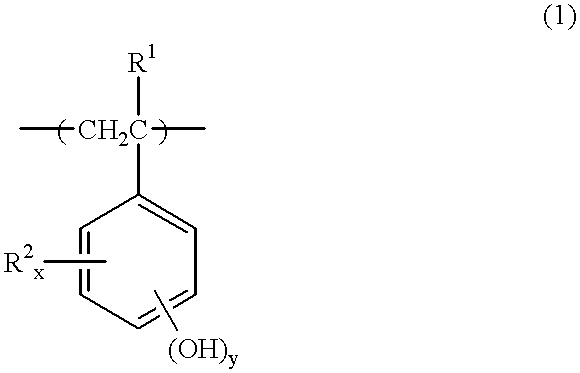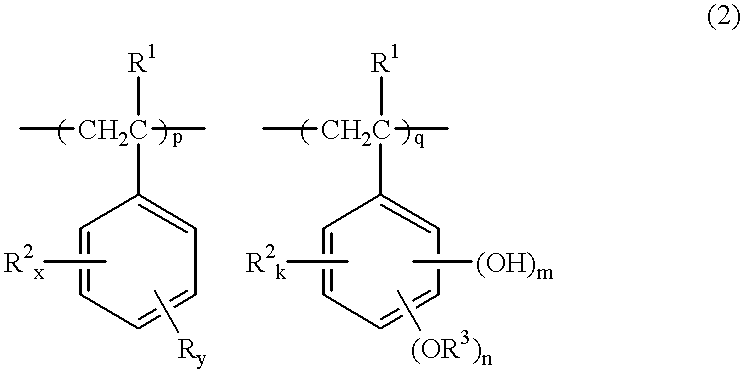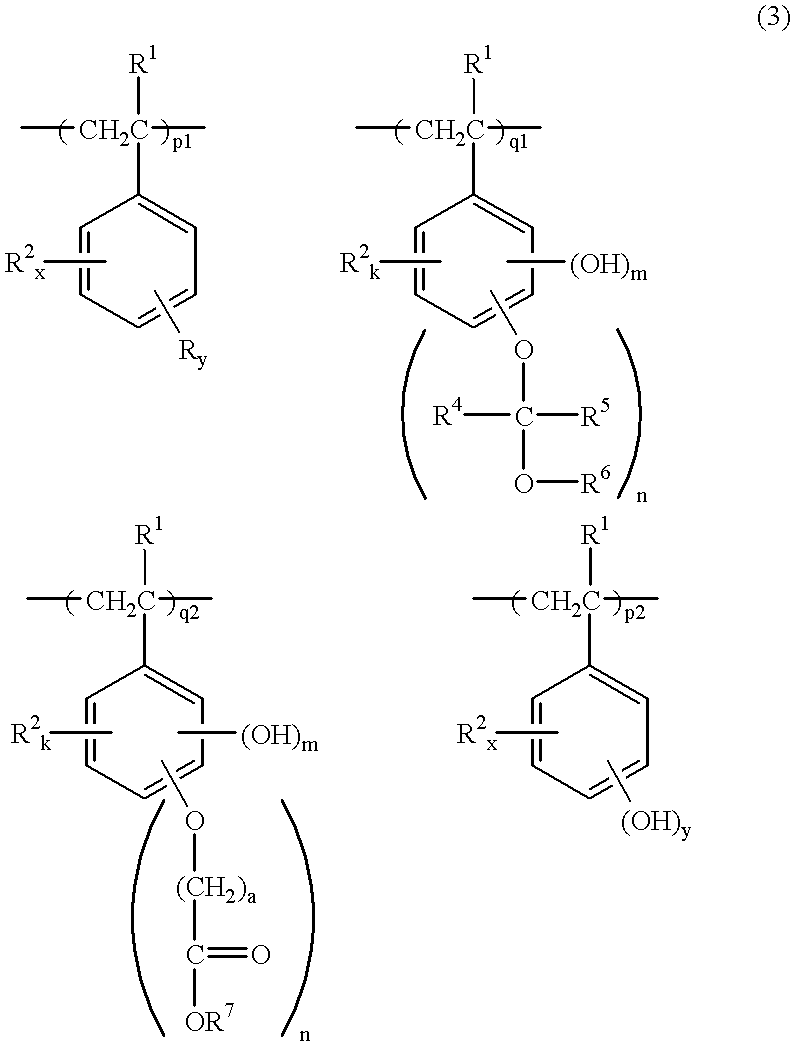Chemically amplified positive resist composition, pattern forming method, and method for preparing polymer having a crosslinking group
a technology of positive resist and composition, applied in the field of chemically amplified positive resist composition, pattern forming method, and method for preparing polymer having a crosslinking group, can solve the problems of significant thinning of pattern shape, low heat resistance, and unsatisfactory sensitivity and resolution
- Summary
- Abstract
- Description
- Claims
- Application Information
AI Technical Summary
Benefits of technology
Problems solved by technology
Method used
Image
Examples
synthesis example 1
In a 2-liter flask, 100 grams of polyhydroxystyrene was dissolved in 1,000 ml of dimethylformamide and a catalytic amount of p-toluenesulfonic acid was added thereto. With stirring at 20.degree. C., 30 grams of ethyl vinyl ether and 2 grams of triethylene glycol divinyl ether were added to the flask. After reaction for one hour, the reaction solution was neutralized with conc. aqueous ammonia and added dropwise to liters of water, yielding white solids. The solids were collected by filtration, dissolved in 500 ml of acetone, and added dropwise to 10 liters of water. After filtration, the solids were dried in vacuum. The thus obtained polymer which had a rational formula (Polym.1) was analyzed by .sup.1 H-NMR to find that the hydrogen atom of a hydroxyl group of polyhydroxystyrene was ethoxyethylated 27% and crosslinked 3%.
synthesis example 2
In a 2-liter flask, 100 grams of polyhydroxystyrene was dissolved in 1,000 ml of dimethylformamide and a catalytic amount of p-toluenesulfonic acid was added thereto. With stirring at 20.degree. C., 30 grams of ethyl vinyl ether and 2 grams of 1,4-di(vinyloxymethyl), cyclohexane were added to the flask. After reaction for one hour, the reaction solution was neutralized with conc. aqueous ammonia and added dropwise to liters of water, yielding white solids. The solids were collected by filtration, dissolved in 500 ml of acetone, and added dropwise to 10 liters of water. After filtration, the solids were dried in vacuum. The thus obtained polymer was analyzed by .sup.1 H-NMR to find that the hydrogen atom of a hydroxyl group of polyhydroxystyrene was ethoxyethylated 27% and crosslinked 3%.
Next, 50 grams of the partially crosslinked ethoxyethylated polyhydroxystyrene was dissolved in 500 ml of pyridine. With stirring at 45.degree. C., 7 grams of di-tert-butyl dicarbonate was added to t...
synthesis example 3
In a 2-liter flask, 50 grams of polyhydroxystyrene was dissolved in 500 ml of dimethylformamide and a catalytic amount of p-toluenesulfonic acid was added thereto. With stirring at 20.degree. C., 27 grams of ethyl vinyl ether and 3 grams of 1,4-di(vinyloxymethyl)cyclohexane were added to the flask. After reaction for one hour, the reaction solution was neutralized with conc. aqueous ammonia and added dropwise to 10 liters of water, yielding white solids. The solids were collected by filtration, dissolved in 500 ml of acetone, and added dropwise to 10 liters of water. After filtration, the solids were dried in vacuum. The thus obtained polymer which had a rational formula (Polym.3) was analyzed by .sup.1 H-NMR to find that the hydrogen atom of a hydroxyl group of polyhydroxystyrene was ethoxyethylated 24% and crosslinked 10%.
PUM
| Property | Measurement | Unit |
|---|---|---|
| mol % | aaaaa | aaaaa |
| wavelength | aaaaa | aaaaa |
| mol % | aaaaa | aaaaa |
Abstract
Description
Claims
Application Information
 Login to View More
Login to View More - R&D
- Intellectual Property
- Life Sciences
- Materials
- Tech Scout
- Unparalleled Data Quality
- Higher Quality Content
- 60% Fewer Hallucinations
Browse by: Latest US Patents, China's latest patents, Technical Efficacy Thesaurus, Application Domain, Technology Topic, Popular Technical Reports.
© 2025 PatSnap. All rights reserved.Legal|Privacy policy|Modern Slavery Act Transparency Statement|Sitemap|About US| Contact US: help@patsnap.com



